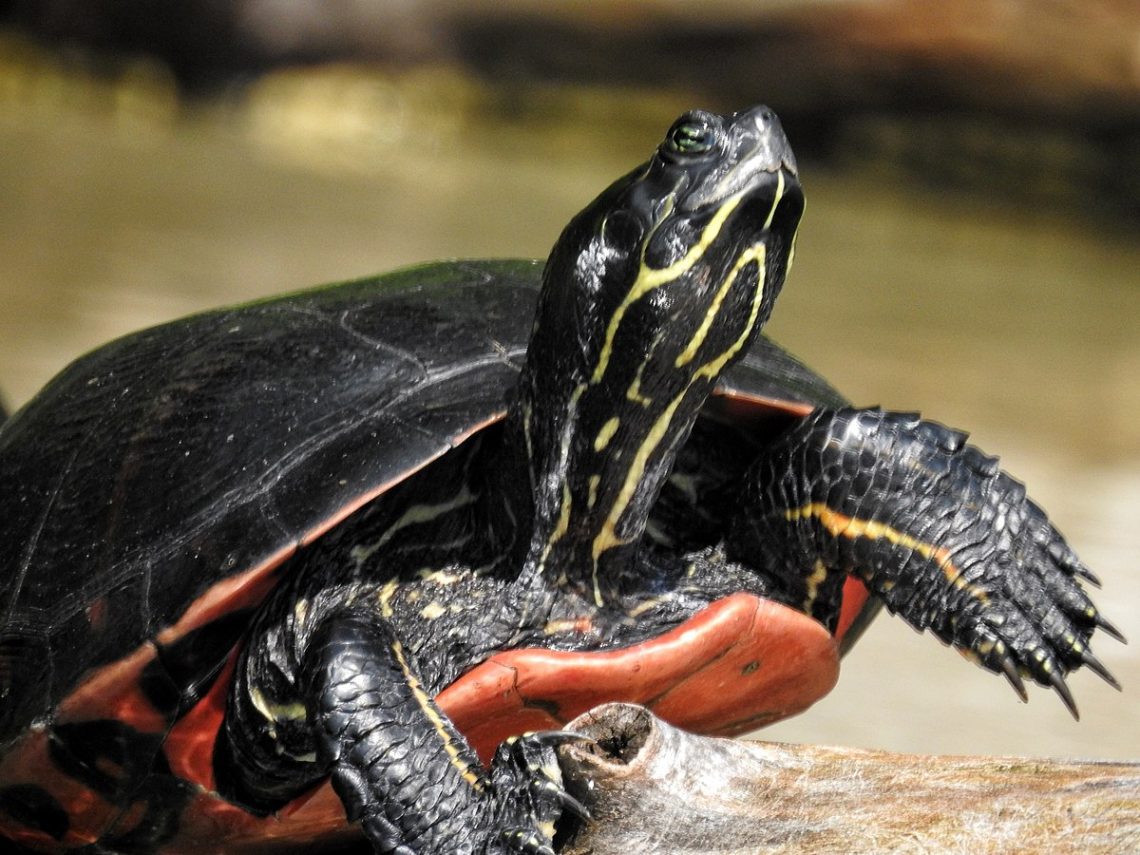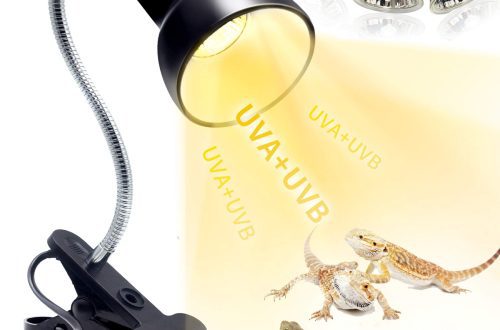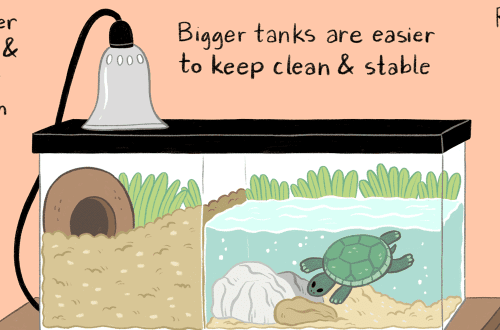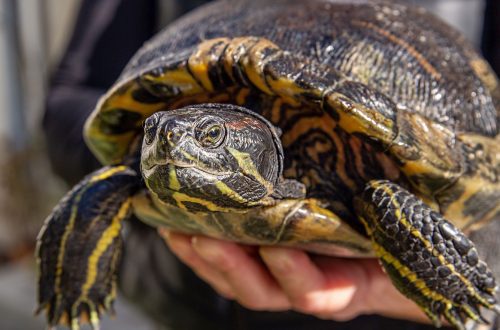
Краснобрюхие чарапахі
Yes, yes, those same little turtles that they are trying to sell us at the subway, on the beach, and so on, often under the guise of unpretentious “decorative” turtles. Many succumb to temptation and acquire this tiny miracle to the delight of their daughter, son or their beloved, not even suspecting what awaits in the future. And it often turns out like in a joke: a “bear” grows out of a “hamster”. The decorative effect promoted by negligent sellers will eventually turn into sizes of the order of 26-30 cm, and unpretentiousness will turn into the purchase of aquaterrariums with the equipment necessary for turtles. Reptiles are very different from mammals in many ways, more so from long-dated cats and dogs. And the conditions of keeping and feeding should be as suitable as possible for the characteristics of their habitat in nature. And what does a person passing by the metro know about the habitat and food of reptiles? Most often, very, very little, sometimes transferring the already existing knowledge about the maintenance of dogs and cats to a species that is absolutely far from them. Hence the errors in keeping (sometimes incompatible with the life of a turtle) and all kinds of diseases that, due to the characteristics of these animals, are noticed by an ignorant owner already at a late stage. That is why, if you decide to have this “little dinosaur relative”, check out the features of their content. Again and again and again I repeat a hundred times that the turtle must definitely live in an aquaterrarium. Do not walk around the apartment and bathe in the bathroom, do not sleep under the covers, even if “she likes it so much!”. No, leave it for cats and dogs, this is their territory, and yours, of course. The turtle has other desires. She needs a spacious aquarium, where the depth of the water should be at least three times the thickness of the shell. With a volume of 100 liters, which will have to be changed as the pet grows. 1/3 of the surface should be occupied by land with a convenient, gentle, non-slippery exit to it. Although the turtle is aquatic, but for normal life in nature it crawls out onto land to bask in the rays of the sun, digest food, and receive its portion of ultraviolet radiation, which is important for the synthesis of vitamin D3 and the absorption of calcium by the body.
And now about how to organize the “sun”.
There should be an incandescent heating lamp and an ultraviolet lamp for reptiles (with a UVB level of 25%, for small turtles 30 is possible) about 5 – 10 cm above the land. Remember, ultraviolet does not pass through glass, so the lamp must be inside. Please note that in the ultraviolet lamp, the intensity of ultraviolet radiation gradually and imperceptibly decreases for a person, so they need to be changed about once every six months. Both lamps should burn all daylight hours, that is, 10 – 12 hours and provide a temperature on land in the region of 32 – 34 degrees, then the water can have a temperature of 24-26 ºС.
Now a little about feeding. The basis of the diet should be low-fat fish, it can be given along with medium-sized vertebrae, the main thing is to remove sharp bones. You can launch live fish into the water, for example, guppies – many turtles do not mind hunting. The diet should also include some algae or lettuce. Additionally, you can give snails, seafood, once every two weeks you can pamper liver (liver, heart). Since such food does not contain enough calcium and other minerals and vitamins, it is imperative to give mineral supplements for reptiles (preferably Reptocal and Reptolife in a ratio of 2: 1 at the rate of 1,5 g per 1 kg of animal weight per week; or powder ” Reptilife “- it is good in composition, but reptiles do not like it very much in terms of taste). Never feed dairy products, dog food, bread, dry fish food to turtles.
It is good if you teach the turtle to feed on land, it is easier to control the supply of mineral supplements, and the water will stay clear longer.
Although turtles are not very sensitive to water pollution, it is necessary to keep it clean by changing the water in parts or completely. It is advisable to install a filter in the aquarium, it will facilitate your care.
As the soil, you do not need to use objects that the turtle can swallow (small stones, shells). Grottoes and large stones are not desirable if you see that the turtle hits them, for example, when it climbs into the water from the island. You can generally leave the bottom without soil. If you have plants in your aquarium, chances are they will serve as dessert for the turtle’s lunch. If, at the behest of your heart, because of great love or for some other reason, you have acquired several turtles, then it may happen that the turtles begin to show aggression towards each other. The only way out is to seat turtles in different terrariums. Some turtles can bite their owners, and quite painfully.
If you have a female turtle, do not be surprised that she is quite capable of laying eggs without the presence of a male in her life.
If you notice that the turtle does not eat, is lethargic, lists on its side in the water, or cannot sink to the bottom at all, if there is discharge from the nose, mouth, lack of feces or its abnormal consistency, color and smell, some lesions on the skin or shell, then this is a reason to attend to the search for a herpetologist. In the nearest clinic around the corner, they are unlikely to take on such an exotic animal, and if they do, then the treatment is far from always adequate.
And a few more points that I would like to draw attention to. Due to conflicting information on the Internet, some owners make a number of mistakes that adversely affect the health of the turtle. You can not wash and clean the shell of turtles with detergents and brushes. Also, do not rub any vitamin oil preparations into it, this will lead to clogging of the pores and the development of bacterial or fungal microflora.
Do not let the turtle walk around the apartment. This is an unfavorable, often dangerous environment for her.
So let’s sum it up:
- The red-eared turtle must definitely live in an aquaterrarium, with convenient land and access to it. The terrarium should be free of objects, stones, artificial plants and shells that the turtle can swallow.
- The temperature on land should be maintained at 32-34 ºС, and water 24-26 ºС.
- Above land, an ultraviolet lamp for reptiles with a level of 10 must burn 12-5.0 hours a day (the lamp must be changed regularly, and remember that glass does not transmit ultraviolet rays).
- The basis of the pet’s diet should be raw fish, low-fat varieties, with the obligatory supply of vitamin and mineral supplements for reptiles throughout their life.
- You can’t keep a turtle in dirty water. Clean the terrarium regularly and change the water, especially if you feed your turtle directly in the water.
- You can not clean and wash the shell with detergents and brushes, as well as rub vitamin oil preparations into it. Also, such drugs should not be given to the eye with food.
- If you have several turtles, and they fight and bite each other, you need to seat them in different terrariums.
- To transport a pet, use a container without water, but with heating.
- Follow the rules of personal hygiene after contact with the turtle and washing the terrarium.





